| Reviews & Columns |
|
Reviews DVD TV on DVD Blu-ray 4K UHD International DVDs In Theaters Reviews by Studio Video Games Features Collector Series DVDs Easter Egg Database Interviews DVD Talk Radio Feature Articles Columns Anime Talk DVD Savant Horror DVDs The M.O.D. Squad Art House HD Talk Silent DVD
|
DVD Talk Forum |
|
|
| Resources |
|
DVD Price Search Customer Service #'s RCE Info Links |
|
Columns
|
|
|
Weird Worlds Collection
Destination Moon (1950):
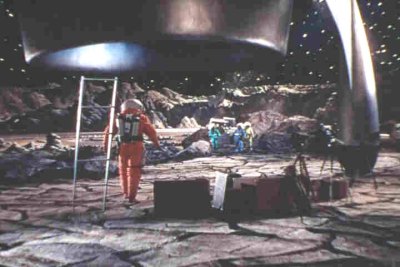 Destination Moon was the first science fiction movie that took the concept of space travel seriously, and strived to be as scientifically accurately as possible. In doing so it heavily influenced science fiction films for decades afterward.
Destination Moon was the first science fiction movie that took the concept of space travel seriously, and strived to be as scientifically accurately as possible. In doing so it heavily influenced science fiction films for decades afterward.
The movie first pitched to Eagle-Lion films by producer Aubrey Schenck (Robinson Crusoe on Mars) and director William Castle (House on Haunted Hill, The Tingler.) They had acquired the rights to Robert A. Heinlein's book Rocketship Galileo and were sure that it had movie potential. Arthur Krim at Eagle-Lion squashed the idea saying that the idea of a man going to the moon was too outrageous. Producer George Pal (War of the Worlds, When Worlds Collide) heard of the idea though, and liked it. He eventually convinced Krim to green light the film.
Pal's project was top notch all the way, even though it had a meager budget of $586,000. Heinlein was hired to help adapt his book, and act as technical advisor. Chesley Bonstell, a painter who specialized in photo-realistic spacescapes was brought on for the matte work.
Pal called his film a "documentary of the future," and took pains to make it scientifically accurate. Every attention was given to detail and realism. From the crews faces being pressed down due to the g-forces during take-off to the weightlessness of free-fall (though this was exaggerated a bit too much), the special effects were state of the art, and very effective. One of the more imaginative effects was used while the ship was on the moon. Midgets were used to double the actors when some of the crew were away from the ship to make that stage appear larger than it really was. The movie won the 1950 Academy Award for special effects.
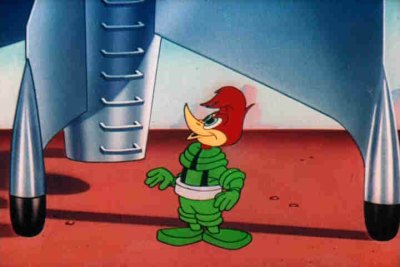 Another thing that the movie had going for it was lots of publicity. It garnered coverage in both movie and mainstream magazine and publications. It may have had too much press. The buzz surrounding the movie was so strong, that it prompted independent movie producer Robert Lippert to rush a similar picture into production. Lippert's picture, the very inferior Rocketship X-M, was completed first, and managed to open two weeks before Destination Moon. Even with this, George Pal's movie succeed, grossing five and a half million dollars during it's theatrical release.
Another thing that the movie had going for it was lots of publicity. It garnered coverage in both movie and mainstream magazine and publications. It may have had too much press. The buzz surrounding the movie was so strong, that it prompted independent movie producer Robert Lippert to rush a similar picture into production. Lippert's picture, the very inferior Rocketship X-M, was completed first, and managed to open two weeks before Destination Moon. Even with this, George Pal's movie succeed, grossing five and a half million dollars during it's theatrical release.
The story is pretty simple and straightforward. Three men; a scientist, an industrialist, and a retired Army general, join forces to finance and construct the first moon rocket. Time is of the essence, since another unnamed, unfriendly country is trying to reach the moon first. They raise the money (with the help of a Woody Woodpecker cartoon,) and the ship is built in the desert. Just as the rocket is completed, it is learned that foreign spies have used the media to turn the populace against the idea of space travel. In a frantic per-dawn lift off, the three heroes and a forth crew member, take off for the moon before the government can stop them.
Since this was adapted from a Heinlein novel, the characters are lively and interesting, if a bit two dimensional. The story isn't driven by the characters however, but by the fantastical plot of a man actually going to the moon. There are enough problems the travelers encounter, both before and after the takeoff, to keep the viewer's attention and make the movie lively.
The one aspect that sets this film apart from the vast majority of SF movies and TV shows that were made before it is the fact that it isn't aimed at young children. This is the first movie that recognizes that science fiction could rise above the level of comic books and kiddie shows. It has fantastic elements (for 1950 at least) but it treats them with respect and uses these to accentuate the drama. While it doesn't have the intensity of The Day the Earth Stood Still or the paranoia and suspense of The Thing from Another World, this is a solid film that didn't look down on it's subject matter and went on to start the SF craze of the 50's.
Project Moon Base (1953):
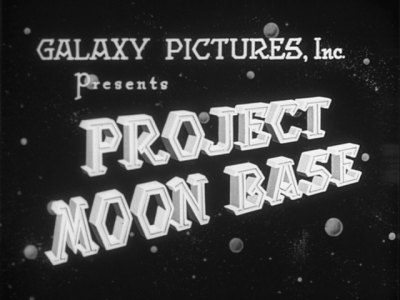 This film also had the involvement of Robert A. Heinlein. He is such a towering figure in the field of SF novels, it's a bit surprising that the films that he was actively involved in didn't turn out better than they did.
This film also had the involvement of Robert A. Heinlein. He is such a towering figure in the field of SF novels, it's a bit surprising that the films that he was actively involved in didn't turn out better than they did.
After Destination Moon, Heinlein's book Space Cadet was turned into the juvenile TV show Tom Corbett, Space Cadet. It was a success and when thoughts of a SF show for older kids came up, Heinlein was naturally considered. He came up with the story for a television show that was going to be called Ring Around the Moon. The first two episodes were shot and when they didn't sell these shows were stitched together to form the feature film Project Moon Base. (Not Project Moonbase (two words instead of three) as it is often erroneously labled by the careless including the person who created the cover for Image.)
As one would expect from the origins of the show, there are really two plots in this movie. The first on involves a cell of foreign spies who are trying to destroy America's space station, since they hate liberty. The group replaces a scientist, Dr. Wernher, who is going to the station with a double that will do their bidding. His mission is to blow up the station at any cost.
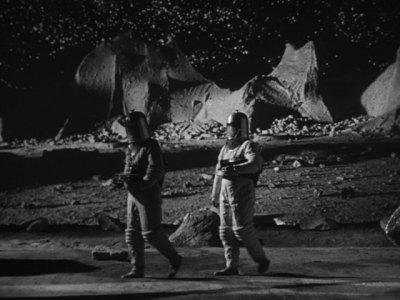 From the space station Dr. Wernher is going to embark on a flight around the moon to search for a suitable spot for a moon base. Maj. Bill Moore is the co-pilot on this trip, and the pilot is Col. Briteis (pronounced "bright eyes") a *gasp* woman. Maj. Moore is obviously in love with Briteis but can't let get over the fact that she out ranks him.
From the space station Dr. Wernher is going to embark on a flight around the moon to search for a suitable spot for a moon base. Maj. Bill Moore is the co-pilot on this trip, and the pilot is Col. Briteis (pronounced "bright eyes") a *gasp* woman. Maj. Moore is obviously in love with Briteis but can't let get over the fact that she out ranks him.
While on the moon trip the doppelganger Wernher tries to take over the space ship and crash it into the space station. Moore fights him off while Briteis pretty much screams, but in the scuffle the ship crash lands on the dark side of the moon.
This starts the second plot, with the three stranded astronauts working together to get word to Earth that they are alive and figuring out how to survive.
There were some good aspects to this film, but much of it was undermined by the slow pace and inane dialog. The idea that a woman could be a space pilot was obviously Heinlein's, but the writers had Briteis spouting dialog that made her seem like a petulant child rather than a competent astronaut. She can't seem to do anything for herself, and the men are always left to save the day.
The special effects are very good for a TV show. The moonscape looks realistic, and the scenes in the space station where people are walking on both the floor and ceiling is very well done. Unfortunately this is overshadowed by the way the show is constructed. Most of the film consists of people sitting in a room talking, and this saps the excitement out of what could have been an interesting show.
Phantom Planet (1961):
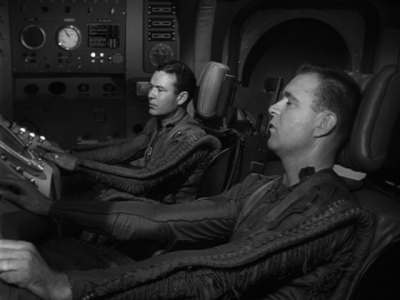 This film has a lot of great SF themes thrown into it. There's a lost civilization, space battles, meteor storms, shrunken astronauts and a horrible monster. What more could you want? Well, a good script and adequate direction for starters. This film totally wastes the promise it has with stodgy direction, nearly uncomprehensible dialog, and seemingly endless scenes of two people talking.
This film has a lot of great SF themes thrown into it. There's a lost civilization, space battles, meteor storms, shrunken astronauts and a horrible monster. What more could you want? Well, a good script and adequate direction for starters. This film totally wastes the promise it has with stodgy direction, nearly uncomprehensible dialog, and seemingly endless scenes of two people talking.
While investigating a series of mysterious space shop crashes, Astronaut Frank Chapman crash lands of the Phantom Planet. He's unharmed, but when he falls and his helmet opens up the air on the planet causes him to shrink in size. He then discovers that the planet, that resembles a piece of Kentucky Fried Chicken, is inhabited. The little people tell Frank how they have been under attack by the Solanites for years. They've been trying to steal their gravity control system, but so far have been unsuccessful. How can Chapman defeat the Solanite invasion, enlarge himself, and get back to his base on the moon without a space ship?
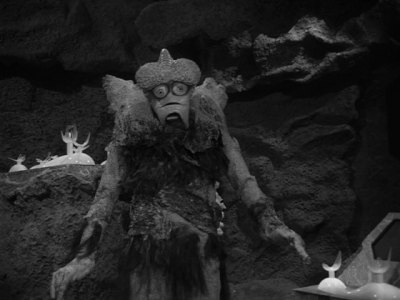 There's so much wrong with this film, it's hard to know where to begin. The direction is probably the biggest offense, so I'll start there. Just about the whole film is done in medium shots and each scene plays out nearly the same way: two people in a room talk and talk and talk, then the end of the conversation is punctuated with a closeup. The camera doesn't move and even the setups and angles are seldomly varied.
There's so much wrong with this film, it's hard to know where to begin. The direction is probably the biggest offense, so I'll start there. Just about the whole film is done in medium shots and each scene plays out nearly the same way: two people in a room talk and talk and talk, then the end of the conversation is punctuated with a closeup. The camera doesn't move and even the setups and angles are seldomly varied.
The script has a lot of interesting aspects, but they don't come about naturally from the plot, it's more like they just threw everything in and hoped that something would strike a cord with viewers. The shrinking Frank Chapman is a good example. There's no reason for him to shrink. He have to pilot his ship while miniature, he's not attacked by regular sized creatures, there's nothing in the plot that needs for him to be six inches tall, but he is.
The dialog (and there's a lot of it) that is delivered much to earnestly. It's also so filled with techno-babble that it's unintentionally funny. It's amazing that the actors could recite lines like "We managed, just in time, to control your landing by releasing the pressure in our space warp." What? Is that supposed to explain anything?
Mystery Science Theater did a great job of sending up this movie and it really deserved it.
First Rocketship on Venus (1962):
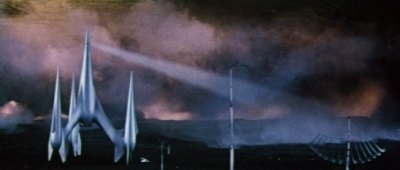 The final movie in this set is an oddity; it is one of the few SF films from behind the Iron Curtain that was theatrically released in the US. A co-production between East Germany and Polish film makers, this film was based on a novel by Stanislaw Lem (Solaris) and has everything that you'd want in an early 60's SF film. There's a cool looking spaceship, a wildly creative alien landscape, and some intriguing mysteries for that the explorers have to solve before they can return home.
The final movie in this set is an oddity; it is one of the few SF films from behind the Iron Curtain that was theatrically released in the US. A co-production between East Germany and Polish film makers, this film was based on a novel by Stanislaw Lem (Solaris) and has everything that you'd want in an early 60's SF film. There's a cool looking spaceship, a wildly creative alien landscape, and some intriguing mysteries for that the explorers have to solve before they can return home.
Taking place in far off 1985, a strange rock is discovered that isn't of Earthly origin. When scientists examine it, they discover an audio message encoded in the artifact and determine that it originated from a space ship from the planet Venus. A team of scientists and explorers from a wide variety of countries is assembled and a rocketship built to take the brave crew to "Earth's sister planet."
On the way to Venus more of the alien artifact is deciphered, and what is discovered isn't good. Apparently the Venusians were planning on attacking Earth and conquering it. Why this plan didn't come off is discovered when the crew gets to the neighboring planet: a nuclear accident wiped out the entire population of the planet. The only things that are left are the automatic systems which are still running. Systems that start to launch the attack on Earth when the visitors accidently activate them.
 It's hard to say anything definitive about this movie based on this version included in this set however since 17 minutes have been cut out of the original film. Instead of the 95 minutes, this version only last 78. (This is the way it appeared theatrically in the US. Alert reader Mark Fountain informs me that the uncut version of the film is available on DVD in R1 under the title The Silent Star. This version is also included in the three film boxed set DEFA Sci-Fi Collection.) In any case, this was a good film, though not prefect. The film starts off well with the mystery of the strange object, and the ending is very good with many creative touches that put it above similar films released at that time. There is a large chunk of the middle that really drags however. When the crew is on their way to Venus, and just before the launch too, things start to move really slowly and don't pick up for a good 15 minutes. Playing chess with a robot and hypothesizing about the planet they are going to doesn't make for an exciting film.
It's hard to say anything definitive about this movie based on this version included in this set however since 17 minutes have been cut out of the original film. Instead of the 95 minutes, this version only last 78. (This is the way it appeared theatrically in the US. Alert reader Mark Fountain informs me that the uncut version of the film is available on DVD in R1 under the title The Silent Star. This version is also included in the three film boxed set DEFA Sci-Fi Collection.) In any case, this was a good film, though not prefect. The film starts off well with the mystery of the strange object, and the ending is very good with many creative touches that put it above similar films released at that time. There is a large chunk of the middle that really drags however. When the crew is on their way to Venus, and just before the launch too, things start to move really slowly and don't pick up for a good 15 minutes. Playing chess with a robot and hypothesizing about the planet they are going to doesn't make for an exciting film.
The end makes up for it however. The last 25-30 minutes of the film are very good. The aliens are actually alien in nature, having many odd an unusual devices and instruments, and the problems that the crew faces keep the viewer's attention. The conclusion is big in scope and well worth slogging through the boring middle section.
The DVD:
This four disc set comes in a double width case with two DVDs on each cover. The discs are placed above each other but displaced so the titles of each disc can be read. The case is clear and comes with a two sided cover. Image has previously released each of these films separately in snapper cases, and these discs are identical to those. The only difference is the art on the discs themselves.
Video:
These films are all acceptable, but they don't look outstanding. Two of the films are in color, (Destination Moon and First Spaceship on Venus) with the others being in black and white. The films are all presented in full frame, as originally released, with the exception of First Spaceship on Venus which is presented with a 2.35:1 widescreen image that is not anamorphically enhanced. The picture is sharp and the colors are generally bright, but the prints are all showing their age. There are scratches and specks throughout all of the films, which can be distracting at times. There are a couple of times where it is clear that a film has been spliced after a film break, and each film seems to have a few frames missing. Digitally they are fine, with no pixelation or other compression defects. For films that are over 50 years old and have generally been neglected, they could have been much worse. As it is they look like a typical unrestored movie from that time period.
Audio:
For all four movies, the audio was presented in Dolby Digital mono, and it, too could have used a little cleaning up. Overall the sound is not bad, but there is a light hiss present the first disc. It is only noticeable when there is near silence, and not very distracting. There are a few pops and crackles over the course of these four films, but the dialog is easy to discern. Though it won't win any awards, it is perfectly acceptable.
Extras:
There are no extras aside from a few trailers scattered over the discs.
Final Thoughts:
Though the title is really stupid (who came up with Weird Worlds anyway?), this is a great example of 50's and 60's low budget science fiction. Destination Moon is an important movie that belongs in a collection of early SF films, and First Spaceship on Venus is also a lot of fun. While the other two are a bit plodding in places, they both have their moments. For a mere $25 MSRP for the collection of four films, and available for much less at several e-tailers, this is a great bargain. A nice set that comes recommended.
|
| Popular Reviews |
| Sponsored Links |
|
|
| Sponsored Links |
|
|
| Release List | Reviews | Shop | Newsletter | Forum | DVD Giveaways | Blu-Ray | Advertise |
|
Copyright 2024 DVDTalk.com All Rights Reserved. Legal Info, Privacy Policy, Terms of Use,
Manage Preferences,
Your Privacy Choices | |||||||













